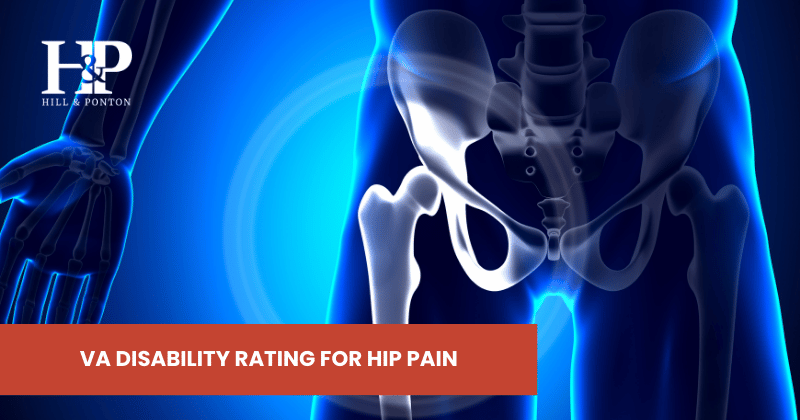The life of a soldier invites physical exertion and wear-and-tear injuries. In-service events as well as other conditions can cause significant hip pain and sometimes lead to chronic disability. This guide will help you understand how to service connect hip pain and get an accurate VA disability rating.
How the VA Rates Hip Pain
Because hip pain can be caused by various injuries or health issues, the VA rating for hip pain will depend on its cause, pain levels and impact on body function (see Ratings by Hip Condition below). The VA also applies the bilateral factor if both hips are affected.
VA Ratings for a Bilateral Hip Condition
When both hips are service connected, the VA combines the disability ratings from each hip and increases it by 10% of its value (so for two hips with 10% rating each the veteran will get a combined rating of 21%). You can estimate your combined (including bilateral) disability rating with the VA disability calculator.
What Is the Maximum VA Rating for Hip Pain?
Hip conditions are assigned a VA rating from 10% for limitation of extension or flexion to a maximum of 90% for extremely unfavorable ankylosis or hip replacement requiring crutches (a temporary 100% rating is given for hip replacement following surgery). Ratings of 80% are assigned for femur fracture or when the hip joint has become completely unstable (flail hip joint).
It can be difficult to get the correct disability rating for hip conditions. If you were underrated by the VA, we may be able to help. Get a free case evaluation here →
Ratings by Hip Condition
Hip pain may be the result of an injury, muscle strain or underlying physical condition, each service-connected in various ways and with very different disability ratings. The most common ones are for ankylosis of the hip and limitation of motion.
Ratings for Ankylosis of the Hip (Diagnostic Code 5250)
Ankylosis (fusion of the hip joint causing stiffness and immobility) is rated at 60% for favorable ankylosis, 70% for intermediate and 90% for extremely unfavorable ankylosis that requires crutches.
- 90% – Extremely unfavorable ankylosis where feet cannot touch ground, requiring crutches
- 70% – Intermediate ankylosis
- 60% – Favorable ankylosis with hip between 20-40 degrees flexion and slight adduction/abduction
Hip Fracture VA Rating (Diagnostic Code 5255)
Fractures in the upper part of the thighbone (femur) that affect the hip joint are rated at 60% or 80% under the diagnostic code for femur fracture. As hip fractures result directly from falls, training accidents, or combat injuries, service connection is straightforward when documented in service records.
Hip Replacement VA Ratings (Diagnostic Code 5054)
- 100% – For 4 months following implantation of prosthesis or resurfacing (starting after the 1-month total rating assigned under § 4.30 following hospital discharge).
- 90% – Following implantation of prosthesis with painful motion or weakness such as to require the use of crutches
- 70% – For markedly severe residual weakness, pain, or limited range of motion
- 50% – For moderately severe residuals including weakness, pain, or limited motion
- 30% – Minimum rating for total hip replacement
VA Note: When the 100 percent evaluation period ends, resurfacing is evaluated under diagnostic codes 5250 through 5255.
Ratings for Arthritis of the Hip (Diagnostic Code 5003)
Hip osteoarthritis happens when the cushion-like cartilage in the hip joint wears down over time. For veterans, this often comes from years of hard physical work, running, and carrying heavy gear during service. When the cartilage wears away, the bones in the hip rub together, causing pain and making it harder to move.
The VA rates hip osteoarthritis at 10% or 20% under diagnostic code 5003, based on X-ray evidence. These ratings are not combined with ratings based on limitation of motion. Learn more about arthritis ratings →
Hip Range of Motion VA Ratings
When hip pain causes limited motion without ankylosis, the VA rates the hip condition based on how it reduces the veteran’s range of movement.
Limitation of Extension (5251):
10% rating – Extension limited to 5 degrees
Limitation of Flexion (5252):
- 40% – Flexion limited to 10 degrees
- 30% – Flexion limited to 20 degrees
- 20% – Flexion limited to 30 degrees
- 10% – Flexion limited to 45 degrees
Impairment of Thigh (5253):
- 20% – Motion lost beyond 10 degrees (limited abduction)
- 10% – Cannot cross legs (limited adduction)
- 10% – Cannot toe-out more than 15 degrees (limited rotation of affected leg)
Hip Impingement VA Rating
Hip impingement, also known as femoroacetabular impingement (FAI) is often rated analogously using the diagnostic codes for limited hip motion, impairment of the thigh, or under the painful motion rule (38 CFR § 4.59), with ratings ranging from 10% to 40%.
Common Military Activities Leading to Service-Connected Hip Impingement
- Repetitive physical training with heavy load bearing
- Parachute jumps with hard landings
- Carrying heavy gear for extended periods
- Combat or training injuries
- Repetitive movements in confined spaces (vehicles, aircraft, etc.)
Many people with hip impingement also have associated labral tears, which can cause more pain and functional limitations and therefore increase the overall disability rating.
Hip Labral Tear VA Disability Rating
Hip labral tears are typically rated analogously under Diagnostic Codes 5251-5253 for limitation of motion or using the painful motion rule. Under DC 5252 for limitation of flexion of the thigh, VA ratings based on limited hip range of motion go from 10% to 40%.
Hip labral tears often occur during physical training, obstacle courses, or from falls during service, but may also develop gradually from repetitive motions required in military occupations.
Hip Strain VA Rating
Hip strain from overuse or injury of muscles or tendons around the hip can be rated based on severity and functional limitations, either from 10% to 40% under Diagnostic Code 5252 (limitation of flexion), or under DC 5253 (impairment of thigh), or under muscle injury codes in the case of muscle damage.
VA Ratings for Hip Pain from Tuberculosis (Diagnostic Code 5001)
Tuberculosis of the hip joint, also called tuberculous arthritis of the hip, happens when tuberculosis bacteria start destroying the hip joint cartilage and bone, causing gradual hip pain and limited range of motion.
The initial tuberculosis receives a 100% disability rating while the disease is active, after which the VA rates it based on residual effects: hip joint damage, pain, limited motion. The VA recognizes this disease as a presumptive condition.
Direct and Secondary Service Connection
Proving that a hip condition is connected to the military service requires three elements:
- Current Diagnosis: You must have a current, medically diagnosed hip condition (not just pain symptoms).
- In-Service Event: Documentation of an injury, disease, or event during military service.
- Medical Nexus: A medical opinion linking your current condition to the in-service event.
But many hip conditions develop from other service-connected disabilities, such as nerve damage or spine conditions that put additional strain on the hips.
Common Secondary Connections
- Hip pain resulting from an altered gait due to a service-connected knee or ankle disability
- Hip degeneration caused by a service-connected back condition
- Hip pain from compensating for other service-connected musculoskeletal disabilities
- Osteoporosis and subsequent hip issues from medications prescribed for service-connected conditions (including epilepsy, PTSD, and others)
- Hip pain resulting from service-connected cancer, like leukemia or bone cancer
- Hip pain from pinched nerves related to service-connected sacroiliitis or sciatica
Case Example: Winning Service Connection After Being Denied
Attorney Shannon Brewer takes a deep dive into the case of a veteran with hip arthritis and other health issues that she ultimately proved to be connected to frostbite in service, in spite of an initial denial. The VA often says that if you don’t have a certain disability at this current moment then they can’t service connect you for that. Find out how to not let this happen to you:
If you were denied VA benefits for your hip disability, our legal team may be able to help you. Get a free evaluation of your case today.
Free case evaluationPresumptive Conditions
In certain situations, the VA presumes that certain conditions are related to military service, eliminating the need to provide evidence of the connection. The following conditions may qualify.
- Arthritis of the hip – Qualifies if it manifests to a compensable degree within one year of discharge and is automatically presumed service-connected for former POWs, particularly post-traumatic osteoarthritis
- Tuberculosis of the hip joint – Presumed service-connected if it becomes active within 3 years of separation from service (or within 3 years for veterans who served before August 19, 1968)
- Multi-symptom illnesses involving hip joint pain – Gulf War Veterans may qualify under Gulf War presumptions for unexplained chronic multi-symptom illnesses that include joint pain affecting the hip
How to Get VA Disability for Hip Pain
Prepare and File the Claim
1. Gather Medical Evidence:
- Military medical records documenting hip issues or related injuries during service
- Post-service medical records showing ongoing treatment
- Private physician opinions and diagnoses
2. Establish Service Connection:
- Obtain a nexus letter from your doctor connecting your hip condition to military service
- Document continuous symptoms since service
- Gather buddy statements from fellow service members who witnessed your injury or symptoms
3. File Your Claim:
- Submit VA Form 21-526EZ for new claims
- Submit VA Form 20-0995 for supplemental claims if previously denied
- File online through eBenefits, by mail, or with a Veterans Service Officer
Attend the C&P Exam
The VA will likely schedule you for a Compensation and Pension exam (C&P). Here’s how to prepare for it.
1. Bring Documentation:
- Gather all your medical and service records relating to your hip pain
- Include a detailed personal journal documenting how your hip pain affects daily activities
- Bring a list of all treatments you’ve tried and their effectiveness
2. Be Honest About Pain Levels:
- Describe your pain on your worst days, not just how you feel the day of the exam
- Explain how the hip pain limits your mobility and activities
- Discuss flare-ups: frequency, duration, and severity
3. Describe Functional Impact:
- Be prepared to discuss how your hip condition affects your ability to work
- Explain limitations in standing, walking, sitting, and other movements
- Describe how your condition has changed over time
Appeal the VA Decision
It’s very common for the VA to deny or underrate veterans. If it happens to you, you have several options to overturn the decision:
- Request a Higher-Level Review
- File a Supplemental Claim with new evidence:
- Appeal to the Board of Veterans’ Appeals
An accredited VA lawyer can help you win your case. Hill & Ponton has over 30 years of experience fighting on behalf of veterans and winning appeals with back pay to the date of the initial claim. Call us today for a free case evaluation.




